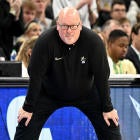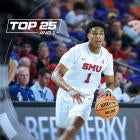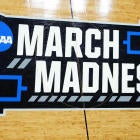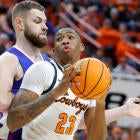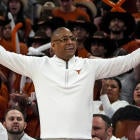According to nearly every established metric, the Big Ten is the best conference in college hoops, a boast it hasn't been able to claim since 2013. Because of this, the Big Ten is going to set the league record for NCAA Tournament bids. It will do this one year removed from ... setting the league record for NCAA Tournament bids.
In 2019, the conference put eight into the Big Dance. In less than three weeks, the worst-case scenario seems to be nine. As many as 11 is still possible. This is angling toward a golden age for Big Ten basketball. If the conference can manage to win its first national championship since Michigan State in 2000, all the better. But on the whole, undeniably: the Big Ten has never been this deep and buff in consecutive seasons.
The renaissance comes after a paltry 2017-18 in which the league put just four teams into that year's tournament, its lowest number in a decade. Oh: 2017-18 was the last season the Big Ten had an 18-game schedule.
Since 2018-19, when the Big Ten became the first conference to activate a 20-game league slate, returns have been gainful. The thickened intra-conference schedule has lifted up the league and enhanced its national profile. High-loss totals are not affecting teams' Bracketology projections the way they often did for decades. As of Wednesday, 10 Big Ten teams are in the top 37 of the NET and 12 are in the top 37 at KenPom. Nine of those 12 teams have 7-10 losses.
But when Selection Sunday arrives, at least two Big Ten schools will be in every corner of the bracket. Multiple regions will have three. Somewhere, former commissioner Jim Delany will be watching and smiling at one of his final machinations in college athletics. It was Delany's impetus that got the Big Ten to move from 16 to 18 league games in 2008, then 20 a decade later.
But Delany was not the sole driver of this.
Purdue coach Matt Painter championed the cause in the spring of 2017 at the Big Ten coaches' meetings. He had to convince some in the league to join the offensive. The biggest reason for going to 20 league games was not explicitly to up the chances for at-large quota, but also to accommodate the Big Ten Network's carriage of game inventory and to lock in/protect geographical rivalries. That meant Indiana and Purdue would play twice every season in perpetuity. Same for Michigan-Michigan State and Illinois-Northwestern.
When the vote was officially cast months after Painter first addressed the coaches, there were still a few not in favor. One who needed convincing was then-Nebraska coach Tim Miles.
"I didn't object to 20 as much has I did the protected rivalries," Miles said. "I understand why they did it and you have to do what's best for the league, but it's a big league. It's not always fair, not equal. I remember some other guys being a little concerned about going to 20, and also with Big Ten/ACC Challenge, Gavitt Games challenge, knowing you might go to a [multi-team exempt tournament] and that stuff. Are we biting off too much here? You look at the early December stuff and you've got ACC/Big Ten Challenge and you hop right into league play."
Painter also tried to show that how trading two league games for lesser-attended "buy" games against Quad 3/4 opponents was optimal. Take the two worst nonconference games off your schedule, replace them with game 19 and 20 in the Big Ten. On the whole this will lift the conference. There were mockups and simulations of seasons, hypothetical schedules with opponents ranked 250th or worse vs. subbing in those two other Big Ten games. Comparisons of 20-game Big Ten schedules vs. 18, showing trajectories and taking into account a forthcoming metric that would be changing how teams were evaluated.
No one knew what it was called, but its arrival was inevitable. A little more than a year later, the NCAA unveiled the NET. Painter was trying to get the Big Ten ahead of the rest of college basketball. And though the seeding and selecting process still aches for tweaks and upgrades, he was right.
"I don't think anything is ever perfect in what they've done, but they were improving their model in terms of helping you get points for winning on the road, helping you get points for winning neutral games, vs. your home games," Painter told CBS Sports. "So there were things getting put in place that's really going to help you, but it was also taking the decision-making out of some coaches' hands because when you deal with older coaches, coaches that have been in it for a long time when you get to a high level, you want to prepare your team.
"Can you get the best players every year to be competitive? It's hard. There's maybe 8-10 schools who can say yes to that, but those guys are going to lose their players and they can go back and get those types of players again. But if you fall into that next threshold, and then now you're trying to grow your program and you have to play better [teams], you have keep harping that you have to stop scheduling teams from 250 down or even 200s period. But it keeps happening, so why not just taking the decision out of their hands?"
A lot agreed. Some still resisted. Painter had spent more than a decade watching the Big Ten fluctuate. He saw opportunity when others were still scheduling based off fallacious RPI ideology.
"I've sat at that table in those meetings and there's 14 coaches, and the one thing I always tell those guys is, 'What's remained constant is the faces in the room change,'" Painter, now in his 15th season at Purdue, told me. "No matter what happens, it's too competitive, people are going to lose their jobs. But you have to take a step back and say, 'What's the one thing that can help us keep our jobs? Getting more teams in the NCAA Tournament.'"
Back to Miles, who was fired in 2019. Remember Nebraska in 2018? It went 22-11, had an at-large-worthy résumé and was kept out by the committee in part because of a lack of opportunity/big wins in league play. The Big Ten's four that made the 2018 NCAAs were Michigan State, Michigan, Ohio State and Purdue. Nebraska only played those four once, then Michigan again in the conference tournament. It went 1-4 against those teams with four games away from home. Even in the dying days of the RPI, Nebraska was unfairly DOA on Selection Sunday.
The 20-game league schedule would go a long way to not having a Nebraska-type scenario happen again.
Here's how the inventory changed. From 2017-18 to 2018-19, Big Ten teams played 28 fewer nonconference games (181 down to 153; it was 152 this season), meaning their quality of opponent on average went up. The number of road games in nonconference play remained mostly static (21, 22, 20) and neutral games a slight dip (39 in 2018, 35 the past two seasons). In 2017-18, the Big Ten won a higher percentage of its noncon games (.751) than this season (.743) but its opponents on balance were collectively worse. That combined with the new scheduling model has been what's allowed the Big Ten to be the best league on balance the past two seasons in college hoops.
"It makes sense from a fan standpoint," Painter said.
Of course, the teams need to win plenty in noncon play (the ACC is in its first season of a 20-game schedule and may only send four to the NCAAs), but if enough teams win enough games in the noncon, the tide rises for all boats and in-league losses don't hurt you as badly.
Ohio State is one of many Big Ten teams benefitting this season. Yes the nonconference wins over Cincinnati, Kentucky and Villanova are huge. As of today -- Feb. 26 -- OSU is 18-9, 8-8 in the Big Ten with four regular season games remaining. It's No. 19 in the NET with a 5-8 mark in Quad 1. On Feb. 26, 2019, Ohio State was 18-10 with an 8-9 Big Ten record and a NET ranking hovering around 40. Buckeyes coach Chris Holtmann said some of this is cyclical, but he's come around.
"I think I was ambivalent on the whole idea for sure," Holtmann told me. "I was concerned about what every coach is concerned about when you've got a 20-game schedule. It's the inability to have flexibility with parts of your schedule you'd like to have flexibility with. … It wasn't that we were trying to trade two additional Big Ten games for two other games that might have a significant advantage in. It was just, overall, listen, we all know that your league is different when you jump into league. It's just completely different. The energy, the wear and tear. It's different."
The league has also hit a lucky cycle this season. Coincidentally, the two worst teams -- Nebraska and Northwestern -- fell in the schedule rotation this season in such a way that none of the other 12 tournament-chasing teams have to play those two more than three times. But the Huskers and Wildcats play each other twice. It's limiting the low-end inventory for the teams still in the at-large conversation.
Removing Nebraska and Northwestern, the other 12 Big Ten teams have an average of 5.7 Quad 1 wins. By comparison, all but the bottom two in the Big 12 average 5.0. The top 12 in ACC average 2.8 Q1 victories. The SEC 3.0, the Pac-12 at 3.1.
So when you check in on Selection Sunday and see nine, 10 or 11 Big Ten teams in the field, understand that this is why the ACC in part went to 20 games and is why the Pac-12 and Big East will do the same starting next season. No guarantees (again: ACC in 2020), but it ups the odds for more teams in the tournament, which can bring more money to the conference. The SEC and AAC are the only power-conference holdouts (the 10-team Big 12 is the only power league incapable of going to 20) and, though I don't think this is a good thing for college basketball as a whole, the biggest leagues are going to look out for themselves, elbowing the lesser conferences in the process.
"Sometimes what coaches don't do is we're slow to react to how something has changed," Painter said. "I thought we were quick to react in comparison to other leagues to that change. Now, the downside to that is there's going to be teams at the lower rungs of Division I having a hard time playing these teams, but you have to do what's best for your league."
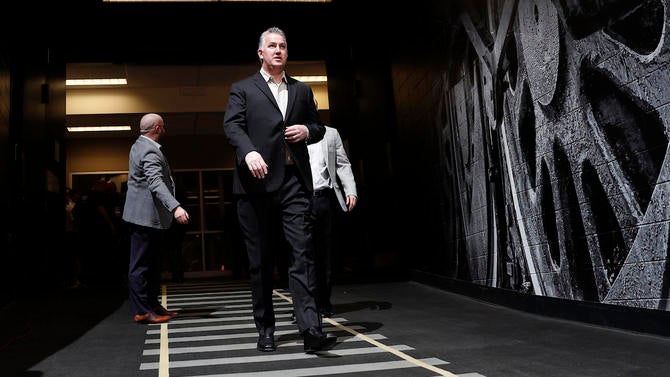
Contrary to accepted belief, there is one undefeated team left
After San Diego State's relatively stunning home loss to UNLV on Saturday, I heard a few variations on this in the ensuing hours: college basketball loses its final undefeated team! Oh, but this is not the case, friends. There is a D-III college in Pennsylvania, on the outskirts of Philly, that is still perfect. The Swarthmore College Garnet -- a liberal arts powerhouse; the school's acceptance rate in 2019 was a stiff 9% -- is 25-0.
This is no shocker, though. The Garnet have been cruising in the D-III rankings at No. 1 since the start of the season. The last time a D-III team went wire to wire without a loss? It was 1999. A guy named Bo Ryan was the coach at Wisconsin-Platteville. Swarthmore is on a tear after losing in last year's D-III title game to Wisconsin-Oshkosh.
Talk about a cultural overhaul, though. The Garnet had just seven winning seasons from 1950-2014; it made its conference tournament once in 64 years. Credit to Garnet coach Landry Kosmalski (the former Bob McKillop assistant helped recruit Stephen Curry to Davidson 15 years ago) for building one of the best programs in college basketball, and hey, who said there are no great teams this season? Swarthmore, give me more! The Garnet's league tournament (Centennial Conference, baby) gets going this weekend. The men's D-III tournament starts March 6. If Swarthmore makes the title game again, the D-III championship will be held April 5, in Atlanta -- the same city as, and the day before, the men's D-I title game.
@ me
Have a Q, curiosity or complaint? Then @ me early and often on Twitter.
It’s about time to talk about @IQ_GodSon being SEC POY on the pod @MattNorlander @GaryParrishCBS.
— David Jenkins (@mrdavidjenkins) February 23, 2020
It's true: Immanuel Quickley has overtaken teammate Nick Richards for SEC Player of the Year. (How about the player development, right? Kentucky does not enough credit for that.) Quickley's averaging 19.2 points in his past 17 games and, as Kentucky's only high-volume 3-point shooter, is hitting 43% of his 3-pointers this season. He had 30 points on 8-of-12 3-point shooting in UK's win at Texas A&M on Tuesday. His growth has been outstanding, and not fully appreciated outside of the Bluegrass State. If Quickley plays to his averages in the next two weeks, the award will be his without debate.
Can you give any insight on why IU struggles in the NET compared to other polls/rankings? Is it just the weak non-con schedule?
— Jake (@iamcohencrazy) February 23, 2020
I noticed this recently for Indiana:
- Strength of Record: 22nd
- Sagarin: 25th
- KPI: 36th
- KenPom: 37th
- BPI: 38th
- NET: 53rd (!)
That gap though. How there can be a 30-spot space between SOR and NET with 27 games worth of data is vexing, particularly when you consider that NET and SOR take nonconference strength of schedule into account and are results-based, not predictive. The Hoosiers are angling toward the NCAAs, but in terms of how they get seeded, it wouldn't surprise me if we get relatively volatile disagreement amongst bracketologists on the morning of Selection Sunday.
@MattNorlander Love you and GP on the pod. With UConn headed back to Big East next year,which CBB team(s) do you think have been helped and hurt most by realignment since say, 2000? Crushed SU fan thinking recruiting against the Hall or Johnnies is better than Duke or UNC.
— Nicholas Knopf (@NicholasKnopf) February 20, 2020
Good question that could evoke a 1,500-word examination column, which I'll spare you from for now. Syracuse has made a Final Four and mostly keep its pace from when it was in the Big East, plus UConn won a national title as a member of the American and has won 58% of its games since switching leagues. From a men's hoops perspective, here are the five schools that have switched conferences in the past 20 years and been worse off. With regard to NCAA Tournament numbers, I am projecting out this season as well, thus one Big Dance for Rutgers:
Boston College (229-256; .472 win%; three NCAATs in 15 seasons in ACC)
Missouri (121-135; .472 win%; two NCAATs in eight seasons in SEC)
Rutgers (91-132; .401 win%; one NCAAT in seven seasons post-Big East)
Pitt (119-100; .520 win%; two NCAATs in seven seasons in ACC)
Temple (126-100; .558 win%; two NCAATs in seven seasons in the American)
@GaryParrishCBS @MattNorlander Morning guys, what is your opinion on the Hall of Fame showcase doubleheader in London this December featuring @KentuckyMBB @umichbball will you be crossing the pond for this event? @EyeOnCBBPodcast
— Jamie Garwood (@JamieGarwood) February 25, 2020
I think it's a wonderful idea to take the Eye on College Basketball Podcast global. And, given my flawless British accent, which has been put on display multiple times on the pod this season, it only makes sense. Surely our bosses will clear this relatively cheap expense. As for the game: Kentucky vs. Michigan in England. I mean, I guess? But in somewhat typical college hoops fashion, the scheduling of this was botched. The Wolverines and Wildcats will tip at 1 p.m. ET ... on an NFL Sunday. Marist vs. UMBC is the other game (for reasons unclear to most).
Final shots
- Shouts to 22-7 Hofstra, shouts to Desure Buie, who is coming off a week averaging 26.5 points, 7.5 assists and 3.0 steals. Hofstra's won eight in a row, its 11 road wins tied for most in college hoops.
- Belmont tends to produce players with interesting statistical profiles. It was a staple of Rick Byrd's career, and now first-year BU coach Casey Alexander has helped Bruins sophomore Grayson Murphy to be the almost-triple-double threat. Check his stat line: 9.8 points, 7.5 rebounds, 6.3 assists, 2.7 steals. He's No. 2 nationally in assist-turnover ratio, is third in steals. Belmont's 22-7 and has won eight straight in the OVC.
- Bowling Green has back-to-back 20-win seasons for the first time since the 1940s. Coach Michael Huger has done a big job there.
- Nebraska is the latest state looking to adopt name, image and likeness legislature that would empower college athletes. While the NCAA scrambles to work with congress for federal oversight, nearly 20 states are moving swiftly with their own interests at stake. Will again be a big story this offseason.
- We'll close with more love for D-III hoops. What a nice, quick video this is. The Dean Bulldogs, out of Franklin, Massachusetts, have the best player in the New England Collegiate Conference. His name is Jordan Booker. And while he was working his fast-food gig (no scholarships in D-III, remember), Booker was notified he'd won the player of the year award.
The Reaction When You Find Out You Are The @NECCathletics #MBB Player Of The Year While Working The 11-4 Shift Of Your Full Time Job. True Definition Of A Student-Athlete! Congratulations, Jordan Booker (@youngkyrie_2)! #WeAreDean #d3hoops #Whyd3 @NCAADIII @DeanMBB @NCAA pic.twitter.com/FHwlUeHfmv
— Dean Bulldogs (@DeanAthletics) February 24, 2020













